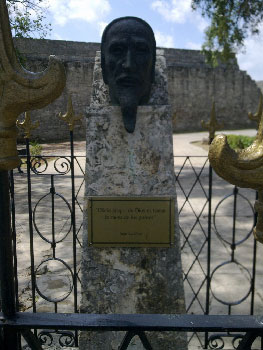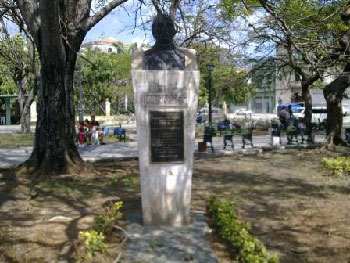Calvin and Kardec, Together in a Havana Park…
Dmitri Prieto

HAVANA TIMES — Not far from a section of the wall which once enclosed Havana’s colonial precursor, in the area where the old town ends and the city’s industrial area begins, a stone’s throw from the boisterous train terminal and the bus stop where people catch the beach-bound 400, there is a quiet little park where the busts of two historically significant figures – those of John Calvin and Allan Kardec – stand together.
In a country like Cuba, filled with busts of Jose Marti and all manner of portraits of Che Guevara, where one comes across many a plaster figure of Saint Lazarus and even of a Sioux native (the emblem of the Native American Commission of Cuban spiritists), these busts are a rare sight indeed.
In their rather outlandish character, they are matched only by the busts of Eva Peron and Dr. Francia. But Evita and Dr. Francia aren’t in the same place. Calvino and Kardec, on the other hand, are practically staring each other in the face.
Calvin was a Christian reformer who is considered the founder of a protestant denomination known in Cuba as the Reformed Presbyterian Church. He upheld the principle that the Bible, and it alone, was the source of truth in all faith-related questions, a conviction that Roman Catholicism preached against.
What he preached would profoundly change the world’s spiritual map. Some, like Max Weber, maintain his teachings also altered the economic map, as the Calvinist or protestant ethic would become one of the pillars of the capitalist mode of production.
There are some, however, who criticize Calvin harshly for his authoritarian ways, which allegedly earned him the derisive appellation of the “Geneva Pope”. It is also said that his influence was decisive in the trial which ended with the execution of the great Spanish physiologist Miguel Servet.
Ironically, Calvin’s monument – whose bust is surrounded by a small, funny-looking fence of sorts – bears an inscription which reads: “Remember that it was God’s role to undertake the cause of the poor.”
Allan Kardec, author of the The Spirits’ Book and the Gospel According to Spiritism (among others), is the founder of spiritualist school which invokes science as the foundation of its various claims.

Kardec claimed to have conducted experiments which offered scientific proof that it was possible to communicate with the disembodied spirits of our ancestors and that these spirits had a profound influence on the affairs of those who still inhabit flesh-and-blood bodies.
“Scientific spiritism” is one the spiritualist schools that exist in Cuba and Kardec is the most quoted authority on the subject. Other spiritualist schools also consider him a great thinker.
That the busts of these two figures should have been erected so close to one another is something of a riddle.
The “unswerving biblical conscience” of Calvin’s Protestant disciples rejects spiritism outright. For spiritualists – and those in Cuba are no exception – the Church has confined Christianity to mere dogma, and only spiritualism can give religious life new impetus.
The “clash of civilizations” staged by placing these two personalities face to face (even if they are only lifeless busts) is comparable, emotionally speaking, to something I saw in London.
Karl Marx’s tomb is located in the Highgate Cemetary (in fact, this is the only tomb “advertised” on its gates, and, ironically enough, Marx sells – when I visited the cemetery five years ago, the entrance was £3.00). However, in front of this crypt, lies the humble, dark orthohedron which marks the final resting place of Herbert Spencer.
One would be hard pressed to find two thinkers as diametrically opposed in their political conceptions as these two – and yet, they sleep side by side, for all eternity.





